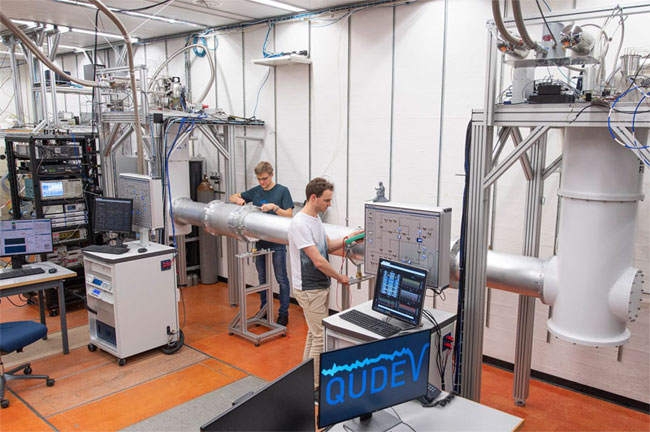In the future, quantum links will connect clusters of quantum computers to form a local network. These links will need to support quantum mechanical superposition states (states that contain the logical values 0 and 1 at the same time). The longest such link to date, based on microwaves, has been built at ETH Zurich, in the laboratory of professor Andreas Wallraff. The microwave quantum link is 5 meters long.
“The challenge was to connect two of those superconducting quantum chips in such a way as to be able to exchange superposition states between them with minimal decoherence,” researcher Philipp Kurpiers said.
To suppress decoherence (the thermal perturbations that can cause a quantum state to lose its superposition property), qubits based on superconducting electrical oscillators need to be cooled to temperatures close to absolute zero (−273.15 °C). Microwave photons that are emitted by one superconducting oscillator and received by another travel through a waveguide that also needs to be cooled so that the quantum states of the photons are not affected while in transit.

The ETH quantum link in Andreas Wallraff’s laboratory. The tube at the center contains the strongly cooled waveguide that connects the two quantum chips in their cryostats via microwave photons. Courtesy of ETH Zurich Department of Physics/Heidi Hostettler.
Using compressed and liquid helium, over a period of several days the researchers cooled each of the quantum chips in a cryostat to a few hundredths of a degree above absolute zero.
The 5-m waveguide that created the quantum link was equipped with a shell consisting of several layers of copper sheeting. Each sheet served as a heat shield for the different temperature stages of the cryostat: −223 °C, −269 °C, −272 °C, and finally −273.15 °C. Together, the heat shields weighed around a quarter of a ton. “This is definitely not a ‘tabletop’ experiment anymore that one can put together on a small workbench,” Wallraff said. “A lot of development work has gone into this, and ETH is an ideal place for building such an ambitious apparatus.”
The researchers showed that the quantum link could be sufficiently cooled down and used to reliably transmit quantum information between two quantum chips. To demonstrate this, they created an entangled state between two chips via the quantum link, making sure that the qubits were far enough apart to rule out any information transfer at the speed of light.
Wallraff and his collaborators continue to perform experiments with the 5-m link, and they have begun work on even longer quantum links. They have been able to sufficiently cool a 10-m link but have not yet performed any quantum experiments with it. They are now working on a 30m quantum link, for which a room at ETH has been specially prepared.
The researchers were scheduled to present their results on the microwave quantum link at the annual meeting of the American Physical Society scheduled for March 2020 in Denver. This conference was canceled, and the results have been reported at the APS Virtual March Meeting.